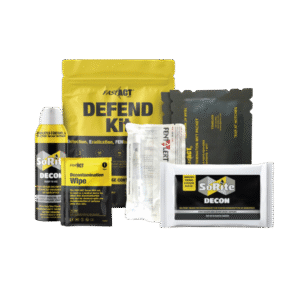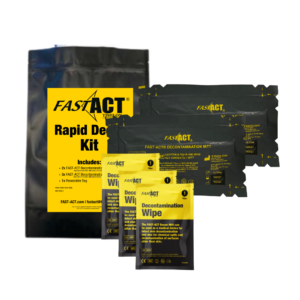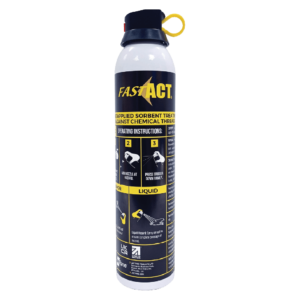Securing 2026 Mega-Event Dry Decontamination Procedures: Why Chemical Decontamination Must Be Part of the Playbook
In 2026, the United States will face one of its most ambitious public safety challenges yet. Hosting the FIFA World Cup while celebrating the nation’s 250th anniversary will place enormous demands on law enforcement, emergency management, and hazardous materials teams. These overlapping mass casualty events intensify risk, complexity, and the need for mega-event dry decontamination procedures across venues, transit hubs, and public spaces.
This blog will explain the scale and stakes of these events, highlight why chemical decontamination and decontamination methods are essential to safety, and reaffirm how FAST-ACT’s solutions merge with personal protective equipment (PPE) and multiagency workflow to deliver readiness, efficiency, and confidence.
2026 Mega-Events: Scope, Risk, and Complexity
Multiple Venues. International Crowds. Elevated Threat Envelope.
The 2026 World Cup is massive: 48 teams, 104 matches, spread across 11 U.S. host cities. This volume of spectators—many international—will press existing infrastructure: airport hubs, transportation networks, stadiums, and security zones. Simultaneously, nationwide celebrations for the 250th anniversary will bring parades, regional festivals, and local gatherings. The overlapping timelines turn every city into a potential pressure point.
Such scale magnifies threat vectors. In a single city, security planners must balance physical security, crowd control, intelligence sharing, and rapid reaction to threats. Host city command posts will need to manage pedestrian flows, barricade layouts, transport corridors, weather events, and resource movements—all while staying alert for hazardous materials or suspected chemical or biological releases.
Evolving Threats Demand Strong Decon Capability
Chemical agents, toxic chemicals, biological agents, or even radiological contamination could be introduced deliberately or accidentally. Terror groups or malicious actors may exploit the publicity of large events to threaten infrastructure or cause panic.
Because intelligence pipelines—federal, state, local, and international—are already strained, failing to embed decontamination techniques or emergency decontamination within event planning invites vulnerability. A chemical or biological release in a fan zone or transit station could rapidly escalate into a mass casualty incident if decon response is delayed, misordered, or hampered by incompatible protocols.
Best practice guidance supports an early, staged response—combining water-based decontamination with dry methods where applicable. The Department of Homeland Security’s PRISM model (Primary Response Incident Scene Management) demonstrates that disrobing and blotting dry can remove up to 99% of contamination before more complex procedures. In mass chemical exposure incidents, speed is critical: delayed decon increases secondary exposures, logistical burden, and risk to responders.
In large-scale settings, prolonged wet decon (showers, runoff handling, rinse labor) is often impractical or slow. Dry decon methods and waterless personnel decontamination must play a leading role in blending speed, safety, and flexibility.
FAST-ACT: Integrating Decon Capability Into Mega-Event Readiness
In the midst of layered event threats, FAST-ACT offers tools engineered to align with Standard Operating Procedures (SOPs), emergency responders, and interagency coordination. Here’s how:
Simple Use. Minimal Training. Broad Coverage.
FAST-ACT products stand out because they require no special training or complex protocols. First responders, HAZMAT teams, law enforcement, and medical units can quickly adopt them within existing SOPs. That means fewer training hours, lower onboarding cost, and more confidence under stress.
Unlike solutions that require multiple product lines for each threat, FAST-ACT provides one solution capable of treating unknown chemical agents, toxic chemicals, or mixed exposures. This reduces logistical overhead and minimizes confusion in multiagency response zones.
Time & Cost Savings: Dry Decon + Wet Decon Synergy
Dry decontamination enables faster response in critical windows. It complements wet decon when water, showers, or rinse systems are available. By using FAST-ACT’s dry method first, agencies can reduce throughput burden, preserve resources, and streamline casualty flow. Combined approaches align with recommended decontamination techniques for high-volume incidents.
Product Capabilities and Use Cases
A comprehensive, field-ready kit designed for rapid fentanyl decontamination on personnel, personal protective clothing, equipment, and surfaces. This all-in-one solution enables pinpoint detection and thorough neutralization of fentanyl and similar synthetic opioids. Ideal for law enforcement, emergency responders, and hazardous material teams, the DEFEND Kit provides reliable protection, minimal training requirements, and immediate peace of mind. Choose to DEFEND. Choose safety.

FAST-ACT Rapid Decon Kit (RDK):
A compact, field-ready kit for neutralizing chemical exposure on personnel, personal protective clothing, gear, and electronics. No mixing, no delay. With FAST-ACT Decontamination Mitts and FAST-ACT Decontamination Wipes, responders can safely treat skin, gear, and high-touch surfaces—even in confined or sensitive areas where traditional bulk methods aren’t feasible.

FAST-ACT 400g Pressurized Cylinder:
Enables vapor and emergency waterless personnel neutralization in confined spaces (tunnels, stairwells, enclosed fan zones).

Operational Scenario: Mega-Event Incident Response
At major public events like the FIFA World Cup or the U.S. 250th anniversary celebrations, potential threats can include unknown powders, chemical releases—intentional or accidental—drone-based dispersal of hazardous materials, or other chemical, biological, or radiological incidents. These environments combine high population density, open venues, and limited response windows, making rapid threat identification and mitigation critical.
In such situations, law enforcement, hazmat teams, and emergency responders must coordinate instantly to isolate the affected area, protect nearby spectators, and deploy decontamination equipment to contain the hazard. Delays or confusion can quickly escalate exposure, turning a localized incident into a mass casualty event.
Here, FAST-ACT’s dry decontamination technology provides critical flexibility. Tools like the Rapid Decon Kit (RDK) and DEFEND Kit allow for immediate, on-site chemical neutralization, even before traditional decontamination facilities are established. Combined with FAST-ACT Decon Mitts, Decon Wipes, and the 400g Pressurized Cylinder, responders can safely manage toxic chemicals or biological agents in dynamic field conditions—protecting both responders and civilians while maintaining operational flow.
Final Thoughts: Advancing Emergency Preparedness and Decontamination Readiness
The collision of the 2026 World Cup and America’s 250th anniversary elevates every domain of public safety. In that environment, mega-event dry decontamination procedures, integrated into SOPs is not optional — it’s essential.
FAST-ACT offers cost-efficient, unified decontamination equipment that saves time, reduces risk, and lowers training overhead. Whether responding to chemical agents, unknown threats, or mixed exposures, the FAST-ACT product line adapts across threats—minimizing the need for redundant tools.
To plan for safety at scale, agencies must include decontamination procedures, emergency decontamination, decontamination stations, and integrated decontamination techniques in their event playbooks.
Contact FAST-ACT today to explore how our solutions can become part of your SOPs, training, and event readiness. Integrate decon capabilities before the spotlight turns to 2026.
About Timilon Corporation:
Timilon Corporation is the manufacturer of FAST-ACT®, a proprietary formulation of non-toxic high-performance specialty materials effective at neutralizing a wide range of toxic chemicals with the added capability to destroy chemical warfare agents. The FAST-ACT technology is utilized by leading defense agencies, chemical industrial companies, first responders and HAZMAT teams to quickly and safely eliminate chemical hazards. For more information, reach out to Leticia Menzzano, Marketing Manager, lmenzzano@timilon.com.

